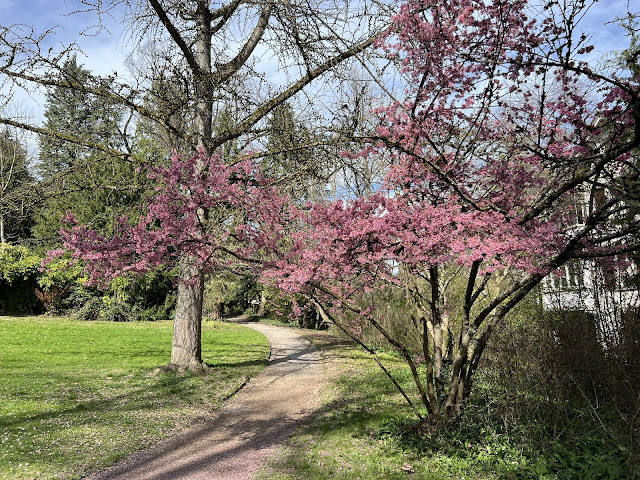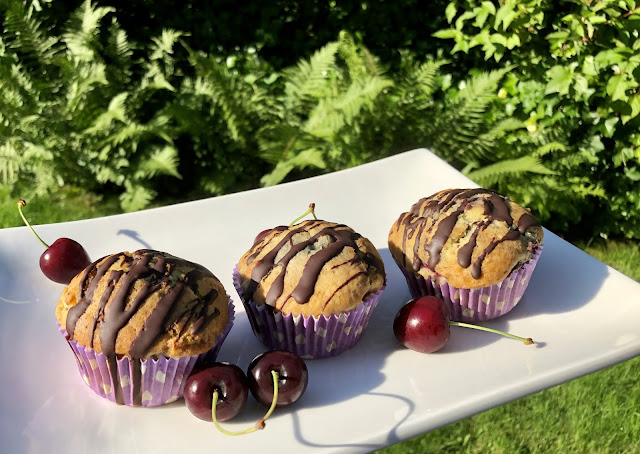It's embarrassing, but it's "thanks" to the 2020 lockdown that I even got aware of the beauty that cherry, magnolia and other blossoms bring. Prior to that I enjoyed spring in general, but didn't pay close attention.
So four years ago when schools were closing with pretty much no notice and no assignments, Colin and I set up our own plan and committed to researching a different country every day: hear music, cook food, look at pictures, learn about what animals live there, etc.
On March 19, 2020, we covered Japan by ordering sushi and venturing to a park where we enjoyed the blooming trees.
Cherry blossom trees are a symbol of Japan. Some people even refer to the cherry blossom as Japan's unofficial national flower. The Japanese school year begins in April, during the cherry blossom season. The blossoms symbolize happiness, love and spring.
Because they only bloom for such a short time, cherry blossom trees also symbolize human mortality. They remind us how short and precious life is.
Let me use this opportunity to send hugs and good vibes to our common blogging friend Martha, who lost her husband of 59 years just this past weekend and to honor our fellow blogger Roy, who was already struggling with serious health problems during our January Challenge, has also passed away.
May they both rest in peace.
What are reasons for such a short blooming period of cherry blossoms?
Genetics: Cherry blossom trees are programmed genetically to bloom for a short period as part of their reproductive cycle. This ensures that they flower when conditions are favorable for pollination and seed production.
Environmental Factors: The blooming period of cherry blossoms is highly dependent on environmental conditions, particularly temperature and weather. A sudden change in temperature, frost, or heavy rainfall can disrupt the blooming process and cause the flowers to wither prematurely.
Pollination: Cherry blossoms rely on pollination by insects, particularly bees, to produce fruit and seeds. The short blooming period aligns with the peak activity of pollinators, ensuring successful pollination within the limited time frame.
Resource Allocation: Trees need to allocate resources efficiently to support various stages of growth and reproduction. By blooming for a short period, cherry blossom trees can conserve energy and resources for other essential functions like leaf growth, photosynthesis, and root development.
Avoiding Competition: Cherry blossoms often bloom in early spring, a time when many other plants are also flowering. By blooming for a short period, cherry blossom trees reduce competition for pollinators and increase the likelihood of successful reproduction.
All in all, I'll say cherry trees are pretty smart! It's up to us to catch them at the exact right time. Makes for some tough planning though.
Every year, the Japanese - and I ;-) - follow the development of the blossoming cherry trees. They call it sakura zensen, the cherry blossom front. With the warmer weather, the blossom slowly moves north. It starts in Okinawa in January and reaches Kyoto and Tokyo in early April.
When the cherry trees bloom in each region, the Japanese celebrate Hanami. This is the tradition of having a picnic under a cherry blossom tree in bloom. This tradition goes back many centuries. It is a time of festivals and celebrations in honor of the cherry blossom.
We don't live in Japan though. Is there any special connection between East Asia and Switzerland where cherry trees are concerned?
I'm glad you asked ;-)







Reading this blog was a roller coaster of emotions for me! I am so sad for the loss of Rich, Martha's husband, and for Roy, our fellow blogger. I didn't know that Roy had passed, so thank you for that information.
ReplyDeleteI also found myself feeling joyful while reading all about the cherry blossom trees. I've learned so much! We have a park here in NJ that has cherry blossom trees but I've never been to see them. My dad grew up in the city where the park is, I'll have to ask him about his experience witnessing the trees bloom as a kid.
Yes, may they both rest peacefully! And I'm adding another hug for our dear Martha!! No, I don't like cherries, but cherry blossoms are beautiful. I haven't always paid attention, either, so I'm glad we have both discovered their beauty. And what a neat thing to do for homeschooling during the pandemic.
ReplyDeleteThose muffins look delicious! It is interesting that I love eating cherries (black ones especially) but I am not a fan of cooked cherries as in a pie. Lovely trees. Great post!
ReplyDeleteThose muffins look delicious! It is interesting that I love eating cherries (black ones especially) but I am not a fan of cooked cherries as in a pie. Lovely trees. Great post!
ReplyDeleteIn Washington DC, there is a cherry blossom festival this time of year. They are so beautiful, but until I read your post, I knew nothing about them! Very informative and always entertaining. And I love how you added in Martha's husband and our friend, Roy - may their memories be a blessing. - XO Elisa
ReplyDelete